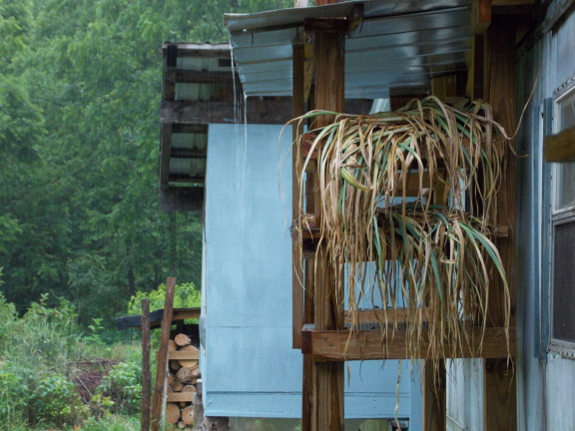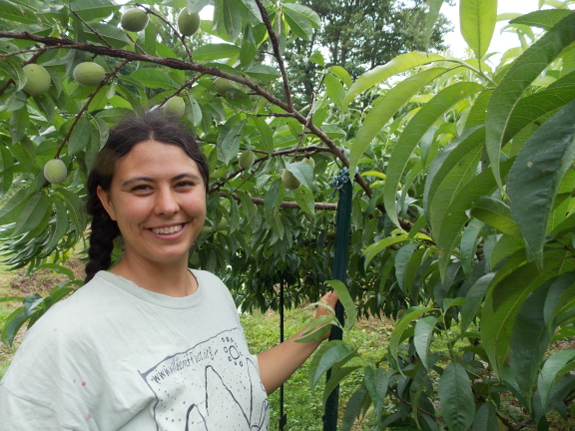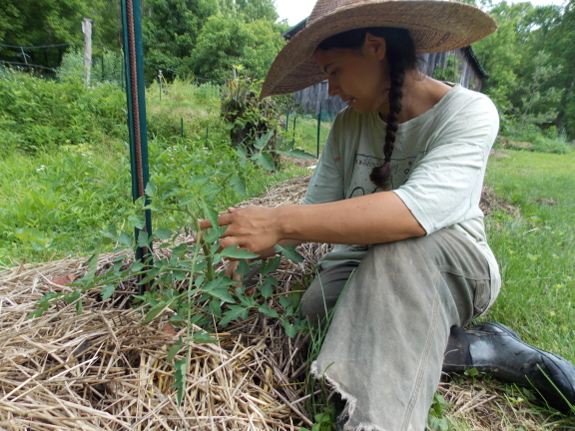
Chemical-free fungal prevention

This light rain was a constant in Aug. '75, when I had morning-sickness and was trying to sort thru curing onions, at the Old House at the Store. A year or 2 earlier, still in that house, it rained all summer, and the bushes expanded, the trees drooped, and Geoff Greene called it "the Mendoty Blues"! Good weather for ducks....

Rain has been a near
constant on the farm so far this year, with no end in sight.
This is our seventh year here, and most have been moderate or "dry"
except for this year and the summer of 2009. (I put "dry" in
quotes because even our driest years are pretty wet, with our
average rainfall being about an inch per week for all twelve
months.)
So I'm taking evasive
action. A few of the peach branches are drooping down toward
the ground under the weight of the developing fruits. I
probably should have thinned harder, but as a stopgap measure, I'm
propping the low limbs up on fence posts to keep them out of the
three-foot fungal zone right above the ground.

And, of course, I'm pruning
and training our tomatoes hard. The toughest part this year has been
finding a time when the leaves are dry enough to touch!
Some of the
strawberries are rotting in the wet, but there are so many that
even losing 20% barely makes a dent in the harvest. I've
taken to picking the fruits slightly unripe, though, to keep decay
at bay.
What kind of
non-chemical fungal-prevention techniques do you use?
Want more in-depth information? Browse through our books.
Or explore more posts by date or by subject.
About us: Anna Hess and Mark Hamilton spent over a decade living self-sufficiently in the mountains of Virginia before moving north to start over from scratch in the foothills of Ohio. They've experimented with permaculture, no-till gardening, trailersteading, home-based microbusinesses and much more, writing about their adventures in both blogs and books.
Want to be notified when new comments are posted on this page? Click on the RSS button after you add a comment to subscribe to the comment feed, or simply check the box beside "email replies to me" while writing your comment.

Just curious if you have your own rain gauge and/or weather station, or if you get your rainfall totals from some of the Weather Service websites? and if so, which brand? (we want to install a weather station on our homestead and are looking for recommendations.)
and yeah, this has been a crazy year, weather-wise. It feels like it might be the new normal, though.
Cheers, Karen
Karen --- I used to use a cheap plastic rain gauge, but after I left two of them out over the winter and they cracked and were ruined, I gave up for the time being. I've dreamed about getting one of those weather stations, but all of the cheap ones seem to be...well...cheap (and likely to die quickly, which just makes me sad).
I did settle on this thermometer as virtually unbreakable, even in our high humidity, and it's been going strong for nearly a year now. Probably the solution for me will be to find something equally durable for rain measurement --- maybe just those cheap plastic rain gauges, but take them in for the winter.
In the meantime, I keep an eye on five gallon buckets scattered across the yard to get a rough estimate of how much rain has fallen. It's very low tech, but works at giving me an idea of whether we've gotten that critical inch of rain per week.
I haven't needed to use this recipe yet (I live in a desert rather than a forest) but this ginger & garlic fungicide recipe looks very promising. http://gilcarandang.com/recipes/ginger-garlic-extract/
I have tried several of the other natural recipes mentioned on the site with good success. I am in the middle of making my own version of fish hydrolysate (fertilizer) but using discarded chicken parts instead of fish. (The author lives in the Philipines where fish is much more plentiful than it is here.)
Oh how I would take some of your rain! I think we have not gotten an inch of rain since winter, This was an interesting post however, ( and I love the hat!)